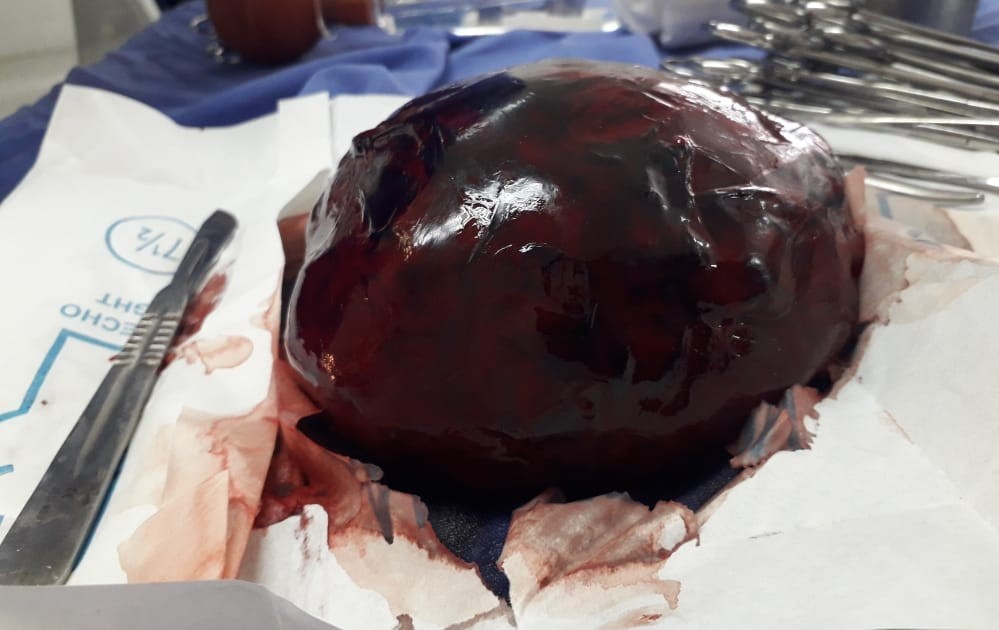An Unusual Intravesical Blood Clot in a Dog
Keywords:
cystectomy, hematuria, neoplasic proliferationAbstract
In canines, when a mass in the bladder is observed by ultrasonography, a malignant tumor is a presumptive diagnosis. In humans, it is common in the presence of clots due to uncontrolled hematuria. We describe the case of a 7-year-old male mixed breed dog, with a clinical history of hematuria 6 months and presence of ticks. Ultrasound studies of the bladder were performed for one month. The evaluations showed a mass in the bladder trigone, covering 80% of the bladder lumen without acoustic shadow, and then a cystectomy was performed. An oval mass was found with irregular borders and clotted blood appearance, with not adherent to the bladder tissue. The histological diagnosis of the mass showed erythrocytes and polymorphonuclear inflammatory cells: neutrophils and mononuclear cells such as macrophages, mixed with moderate fibrin threads compatible with a bladder clot. Therefore, the diagnosis was a benign mass and not a transitional cell carcinoma as usual. Masses found in the bladder are not necessarily a neoplastic proliferation.
e2023-3
http://dx.doi.org/10.21929/abavet2023.12
https://www.youtube.com/watch?v=fFPsoHNCpqg
References
BORIA-GAMBOA BP, Villagómez-Cortes JA, Martínez-Herrera D. 2019. Clinical Evidence of lyme disease in dogs and disease awareness among students and veterinarians in Veracruz, Mexico. Veterinary Science Research. 1(2):10-17. ISSN: 2661-3867.
https://doi.org/10.30564/vsr.v1i2.1280
CHILDRESS MO, Adams LG, Ramos-Vara JA, Freeman LJ, He S, Constable PD, Knapp DW. 2011. Results of biopsy via transurethral cystoscopy and cystotomy for diagnosis of transitional cell carcinoma of the urinary bladder and urethra in dogs: 92 cases (2003-2008). Journal of the American Veterinary Medical Association. 239(3):350-356. ISSN:0003-1488.
https://doi.org/10.2460/javma.239.3.350
CHOCHLIOS TA, Angelidou E, Kritsepi-Konstantinou M, Koutinas CK, Mylonakis ME. 2019. Seroprevalence and risk factors associated with Ehrlichia canis in a hospital canine population. Veterinary Clinical Pathology. 48(2):305-309. ISSN:1939-165X.
https://doi.org/10.1111/vcp.12736
DE SANTIS F, Boari A, Dondi F, Crisi PE. 2022. Drug-dosing adjustment in dogs and cats with chronic kidney disease. Animals. 12(3):262. ISSN: 2076-2615.
https://doi.org/10.3390/ani12030262
DUNAEVICH A, Chen H, Musseri D, Kuzi S, Mazaki-Tovi M, Aroch I, Segev G. 2020. Acute on chronic kidney disease in dogs: Etiology, clinical and clinicopathologic findings, prognostic markers, and survival. Journal of Veterinary Internal Medicine. 34(6):2507-2515. ISSN:1939-1676.
https://doi.org/10.1111/jvim.15931
FULKERSON CM, Knapp DW. 2015. Management of transitional cell carcinoma of the urinary bladder in dogs: a review. The Veterinary Journal. 205(2):217-225. ISSN:1532-2971.
http://doi.org/10.1016/j.tvjl.2015.01.017
HARRIMAN GM, Popovitch C, MacLeod A. 2016. Ultrasound evaluation of the urinary bladder in dogs following cystotomy with full thickness suture placement. Journal of American Animal Hospital Association. 52(4):212-219. ISSN:1547-3317.
http://doi.org/10.5326/JAAHA-MS-6381
MARTINS-LEAL L, Fernandes-Machado MR, Bignotto-Ferreira F, Didoné EM, Bruno de Souza I. 2012. Transitional cell carcinoma in dogs: a report of two cases, mother and daughter. Revista de Investigaciones Veterinarias del Perú. 23(4):516-522. ISSN:1682-3419
http://doi.org/10.15381/rivep.v23i4.973
MOLONEY F , Murphy KP, Twomey M, O'Connor OJ, Maher MM. 2014. Haematuria: An Imaging Guide. Advances in Urology. ISSN: 16876377, 16876369.
https://doi.org/10.1155/2014/414125
NUNURA J, Navarro J. 2004. Hemorrhagic cystitis in bone marrow transplant recipients: First report of cases in our country. Anales de la Facultad de Medicina. 65(2):138-146. ISSN:1025-5583
http://dev.scielo.org.pe/pdf/afm/v65n2/a09v65n2.pdf
NUÑEZ-OCHOA L, Bouda J. 2007. Patología Clínica Veterinaria. Universidad Nacional Autonoma de México, Ciudad de México. ISBN:9703245501. Pp. 233.
RASTEIRO AM, Sá E Lemos E, Oliveira PA, Gil da Costa RM. 2022. Molecular markers in urinary bladder cancer: applications for diagnosis, prognosis and therapy. Veterinary Science. 28(9):107. ISSN:2306-7381.
http://doi.org/10.3390/vetsci9030107
RODRÍGUEZ-ALARCÓN CA, Beristain-Ruiz DM, Olivares-Muñoz A, Quezada-Casasola A, Pérez-Casio F, Álvarez-Martínez JA, Tapia-Alanía J, Lira-Amaya JJ, Rivera-Barreno R, Cera-Hurtado OS, Ibancovichi-Camarillo JA, SoonGómez L, Adame-Gallegos JR, Figueroa-Millan JV. 2020. Demonstrating the presence of Ehrlichia canis DNA from different tissues of dogs with suspected subclinical ehrlichiosis. Parasites & Vectors. 13(1):518. ISSN:1756-3305.
http://doi.org/10.1186/s13071-020-04363-0
VISSER J, Kummeling A, van Nugteren MA, Grinwis GCM, Brocks BAW. 2020. Resection of urachal anomalies in dogs with recurrent lower urinary tract disease. Veterinary Surgery. 49(1):214-221. ISSN:1532-950X.
https://doi.org/10.1111/vsu.13311
XU M, Jin L, Shan Y, Zhu J, Xue B. 2020. A simple and effective method for bladder blood clot evacuation using hydrogen peroxide. The Journal of International Medical Research. 48(5). ISSN: 13412051.
https://doi.org/10.1177/0300060520924546
ZHAO S, Cui L, Zheng X, Ji Y, Yu C. 2022. Meloxicam alleviates sepsis-induced kidney injury by suppression of inflammation and apoptosis via upregulating GPNMB. Applied Bionics and Biomechanics. e1790104. ISSN: 11762322.



